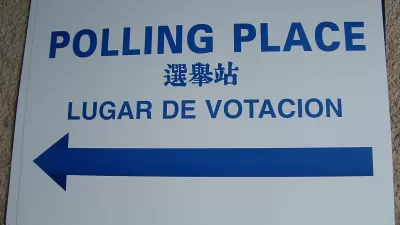Urban densities tend to encourage more liberal, tolerant values. Living among diverse neighbors can reduce fear and resentment, as everyday interactions break down stereotypes and misconceptions of ‘the other.’

Neeraj Bhatia, founder of The Open Workshop and assistant professor at the California College of the Arts, introduces an article titled "Environment as Politics":
One lesson of the U.S. presidential election is that we should forget about red and blue states, North and South, coastal coffeeshops and heartland diners. The geographic divide in American politics is closer to home. If you want to predict how someone will vote, ask, How near are your neighbors?
In the recent U.S. election, 49 of the 50 highest density counties voted for Hillary Clinton, and 48 of the 50 lowest density counties chose Donald Trump (nearly the same split as for Barack Obama and Mitt Romney four years earlier).
There are reasons for this that go beyond identity politics. Urban density has social and economic advantages that make cities attractive to liberals and that also condition liberal values over time. Living among diverse neighbors can reduce fear and resentment, as everyday interactions break down stereotypes and misconceptions of ‘the other.’ (Which is not to ignore that cities have their own problems with racial and economic segregation.
FULL STORY: Environment as Politics. New drawings of the relation between residential density and voting behavior.

Planetizen Federal Action Tracker
A weekly monitor of how Trump’s orders and actions are impacting planners and planning in America.

San Francisco's School District Spent $105M To Build Affordable Housing for Teachers — And That's Just the Beginning
SFUSD joins a growing list of school districts using their land holdings to address housing affordability challenges faced by their own employees.

The Tiny, Adorable $7,000 Car Turning Japan Onto EVs
The single seat Mibot charges from a regular plug as quickly as an iPad, and is about half the price of an average EV.

San Diego Votes to Rein in “Towering” ADUs
City council voted to limit the number of units in accessory buildings to six — after confronting backyard developments of up to 100 units behind a single family home.

Texas Legislature’s Surprising Pro-Housing Swing
Smaller homes on smaller lots, office to apartment conversions, and 40% less say for NIMBYs, vote state lawmakers.

Even Edmonton Wants Single Staircase Buildings
Canada's second most affordable major city joins those angling to nix the requirement for two staircases in multi-family buildings.
Urban Design for Planners 1: Software Tools
This six-course series explores essential urban design concepts using open source software and equips planners with the tools they need to participate fully in the urban design process.
Planning for Universal Design
Learn the tools for implementing Universal Design in planning regulations.
Borough of Carlisle
Smith Gee Studio
City of Camden Redevelopment Agency
City of Astoria
Transportation Research & Education Center (TREC) at Portland State University
City of Camden Redevelopment Agency
Municipality of Princeton (NJ)




























